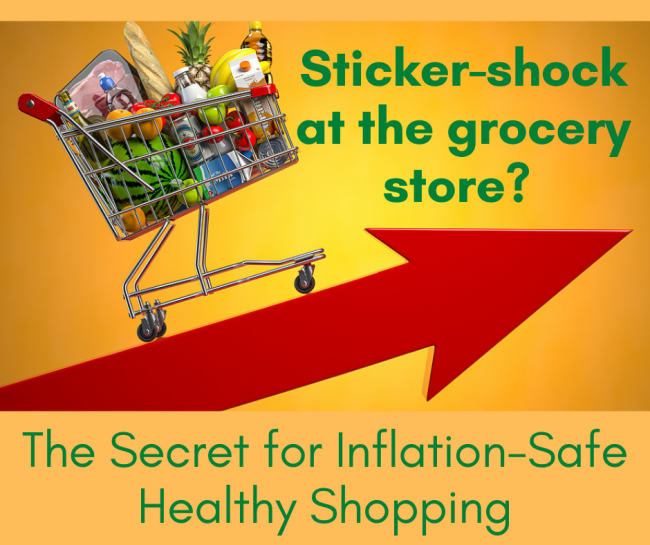“Wow, food prices have really gone up!” My son had just gone grocery shopping and was shocked that his usual 10-15 items cost several dollars more than usual.
While his surprise was certainly warranted, it wasn’t really surprising. News articles have been warning us about inflation for several weeks. For instance, one forewarned that “Rising Costs Press Food Makers.” And then another informed that “Inflation Approaches a Tipping Point at the Grocery Store.” (1)
Now we’re finally seeing those warnings show up at the grocery store–and it can be alarming!
Buried within those two articles, however, is the key to moderate inflation’s sticker-shock. Both explain that consumer prices are going up because food manufacturers are facing higher costs for things like labor, transportation, steel cans, plastic packaging, and manufacturing bottlenecks.
Knowing what’s driving inflation highlights the secret for inflation-safe healthy shopping:
Eat Lower on the Food Chain
This is the case because packaged, prepared and ready-made foods are particularly sensitive to increases in manufacturers’ costs of goods. Just consider what it takes to manufacture a frozen meal, even something as simple as a chicken noodle stir fry.
- Chicken must be shipped into the factory, along with several vegetables, noodles and various sauce ingredients, all from different manufacturers that are facing their own price increases.
- Labor and manufacturing capacity (both in short supply) are required to cut, mix and turn those raw ingredients into a meal.
- Both freezer-safe and cardboard packaging and film must be shipped in and more manufacturing capacity is required to package the meal.
- Then individual packages have to be packed in big boxes and transported in freezing temperatures to warehouses, then to the grocery store, and then manually stocked into freezers in the grocery aisle.
- And every step of the way requires a great deal of energy, which is also soaring in price.
Think how many of these increased costs could be avoided if you short-circuited this long, convoluted, very expensive process and made your own chicken stir-fry?
- Consider just the chicken: It would still need to be butchered and shipped to your grocery store, but at least it would not have to be routed through, e.g., New Jersey where a frozen meal might be made. It would still need plastic packaging, but at least not an outer cardboard box. Buying it fresh also means you eliminate all the costs of shipping frozen foods.
- Now what if you bought the vegetables directly from the produce section or, better yet, from a local farmers market or farm stand?
- What if you made your own sauce instead of a ready-made one that requires shipping from multiple sources and manufacturing time and labor?
- What if you buy a big bag of rice that can be shipping just once rather than individual bags of noodles?
Making meals from the ground up is the way we traditionally ate–and it was better for our health as well as our pocketbook. As always, this runs us smack dab into the need for more involvement in and engagement with the kitchen. But interestingly, the pocketbook often instigates healthier eating better than just the promise of good health. So maybe this is food inflation’s silver lining?!
As always, if you don’t feel comfortable and capable eating lower on the food chain, remember my mission: To help busy people re-skill themselves so making health-giving, everyday meals is not only ease-ful but enjoyable. Check out the classes on my website and Vimeo channel–and be sure to join me for our November FREE classes. Sign up for my newsletter to find out more.
(1) WSJ 10/8/21 p. B1; WSJ 10/21/21 p. B12
